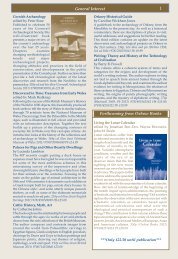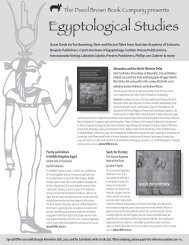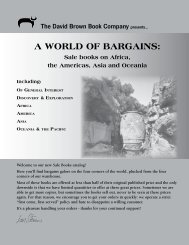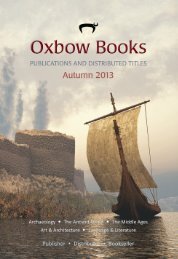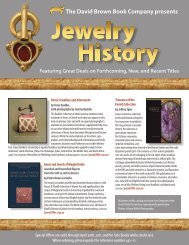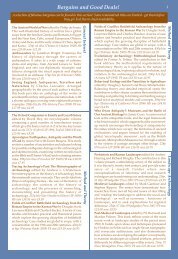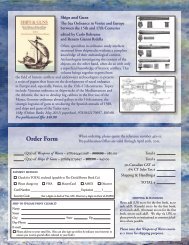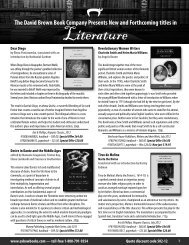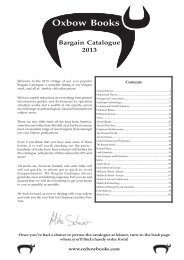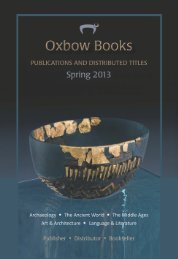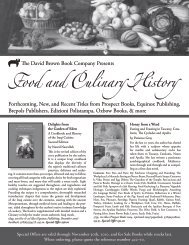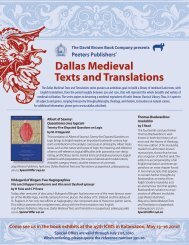New Distributed Titles Fall 2009 - Oxbow Books
New Distributed Titles Fall 2009 - Oxbow Books
New Distributed Titles Fall 2009 - Oxbow Books
Create successful ePaper yourself
Turn your PDF publications into a flip-book with our unique Google optimized e-Paper software.
culinary studies Prospect <strong>Books</strong><br />
Sir Hugh Plat<br />
The Search for Useful Knowledge<br />
in Early-Modern London<br />
by Malcolm Thick<br />
This volume launches an<br />
investigation of the life<br />
and work of Sir Hugh Plat<br />
(1552–1611), an author,<br />
alchemist, speculator and<br />
inventor whose career<br />
touched on the fields of<br />
alchemy, general scientific<br />
curiosity, cookery and sugar<br />
work, cosmetics, gardening<br />
and agriculture, food manufacture,<br />
victualing, supplies<br />
and marketing. Much manuscript material, in the form of notebooks<br />
and workings, has survived. The author illustrates Plat<br />
as a gentlemen of varied interests, a Londoner trying to make<br />
his way in the world, and as a man of his time and place. The<br />
chapters, backed up by a full bibliography, references and documentary<br />
appendices, are as follows: Introduction; Biography;<br />
Gardening; Agriculture; Military Food & Medicine; The Writing<br />
of Delightes for Ladies and Sundrie new and artificiall remedies<br />
against famine; Alchemy; Medicine; Scientific Thought and<br />
Technique; Inventions; Moneymaking.<br />
320p, 4 b/w illus, hardback, 9781903018651, $60.00,<br />
Prospect <strong>Books</strong>, December <strong>2009</strong>.<br />
76<br />
The Realm of Fig and Quince<br />
An Anthology of Recipes<br />
by Ria Loohuizen<br />
Quince and fig must be the most romantic of all European fruits, perhaps because they<br />
are among the oldest, perhaps because the luxury of their perfume and texture provokes<br />
the most enthusiastic of responses in the poetry and prose of Persia, of Greece,<br />
and of the West itself. The author offers a blend of history, anecdote, literary reference<br />
and recipes. Because the quince has so particular and pungent a flavor, it was the precursor<br />
ingredient of many marmalades and conserves. Loohuizen’s recipes range wider<br />
than Europe, including Persia to the east and North Africa to the south, for the stamping<br />
grounds of these fruits were far greater than merely the West. Some of them are truly<br />
enticing: chicken with quince and walnut sauce; quince sherbet; Turkish stuffed quinces; quince mostarda; savoy cabbage with<br />
fennel and quince; anchovy and fig sauce with fried shrimp; stuffed figs with olive oil ice cream; rabbit with figs.<br />
128p, 6 b/w illus, paperback, 9781903018743, $19.95, Prospect <strong>Books</strong>, December <strong>2009</strong>.<br />
Over a Red-Hot Stove<br />
Essays in Early Cooking Technology<br />
edited by Ivan Day<br />
These essays were presented at the seventeenth Leeds<br />
Symposium on Food History. Their common theme is the way<br />
in which we cooked our food from the medieval to the modern<br />
eras, most especially, how we roasted meats. The authors are<br />
distinguished food historians, mostly from the north of England.<br />
Discussion include: the rise of the kitchen range; techniques of<br />
roasting; the reconstruction of the kitchens at Hampton Court<br />
and other Royal Palaces; yeast as a raising agent; running a masonry<br />
wood-fired oven in living-history museums in America. The book is very generously illustrated,<br />
both by photographs of artefacts and reproductions of early prints and engravings that elucidate their<br />
purpose and function.<br />
208p, 78 b/w illus, hardback, 9781903018675, $60.00, Prospect <strong>Books</strong>, November <strong>2009</strong>, Food and Society 14.<br />
The Fruit, Herbs & Vegetables of Italy (1614)<br />
by Giacomo Castelvetro,<br />
edited and translated by Gillian Riley<br />
This is a new edition of a classic of early 17th-century food<br />
writing. The book was written by the Italian refugee, educator,<br />
and humanist Giacomo Castelvetro, who had been saved from<br />
the clutches of the Inquisition in Venice by the English ambassador<br />
in 1611. Castelvetro takes us through the gardener’s year,<br />
listing the fruit and vegetables as they come into season, with<br />
simple and elegant ways of preparing them. Practical instructions<br />
are interspersed with tender vignettes of his life.<br />
176p, paperback, 9781903018644, $24.00, Prospect <strong>Books</strong>, December <strong>2009</strong>.<br />
The David Brown Book Company – <strong>Fall</strong> <strong>2009</strong>




